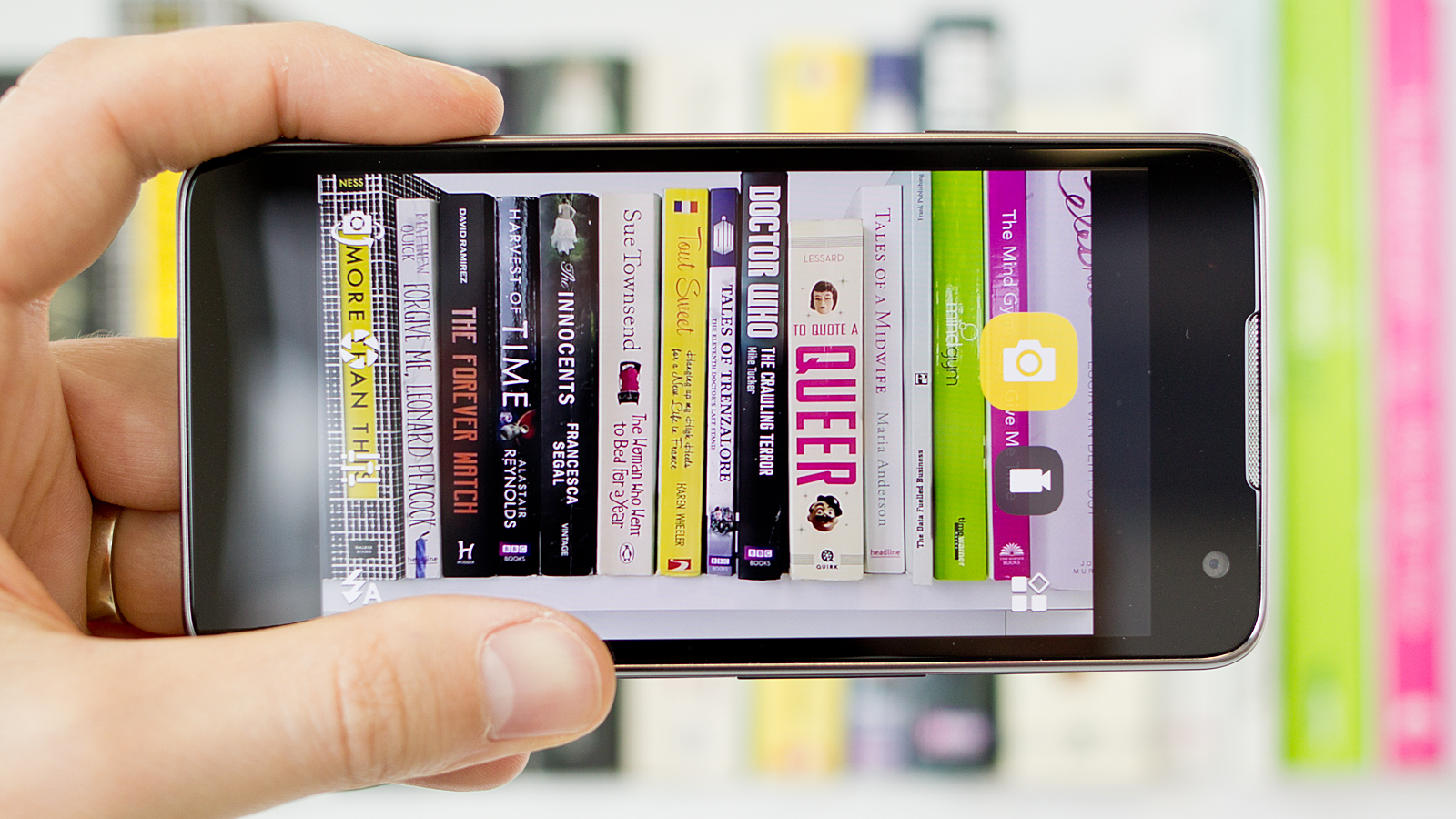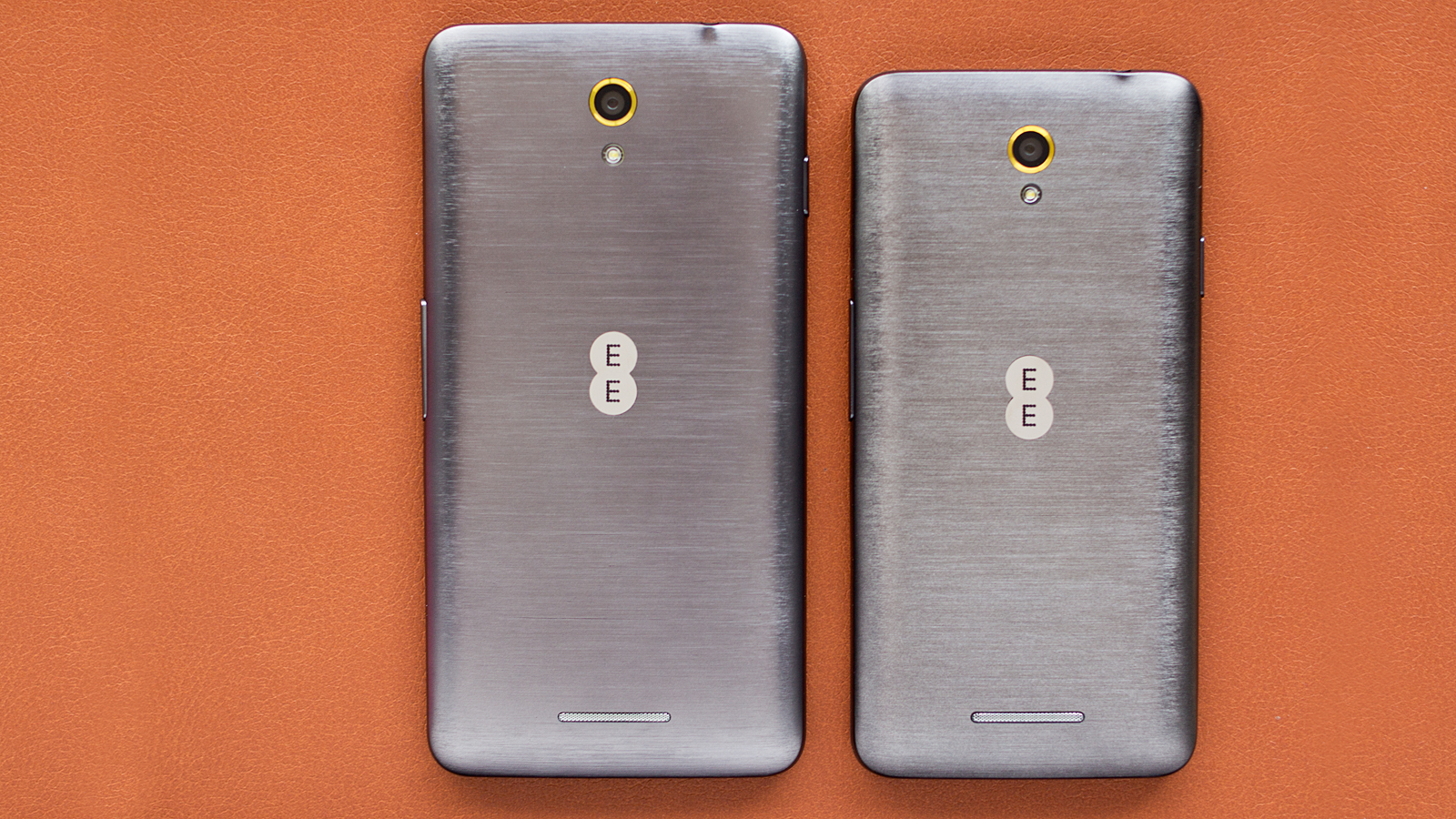At £99 the EE Harrier Mini offers a cheap entry point for a phone capable of fast 4G data download speeds, but EE isn’t the only UK mobile operator to offer its own-brand cheap 4G phone. Vodafone has also recently unveiled its Smart Prime 6, and at £79 it arguably offers better value than the Harrier Mini. With very similar specifications, including a 1.2GHz processor, 1GB of RAM, 8GB of storage and 8-/2Mp cameras, there’s little to differentiate between Harrier Mini and Smart Prime 6. Both are a step up on the Moto E 4G, which is now available for around £89 but has an inferior qHD screen and cameras. The Harrier Mini also boasts EE Wi-Fi Calling, which lets you route calls and texts over Wi-Fi when you’re out of range. The Harrier Mini is identical in design to its bigger brother, the EE Harrier, but with smaller dimensions and a more modest spec. Its performance in our benchmarks was less impressive, but in real-world use it somehow felt faster, and switching between home screens and scrolling through menus is a zippy affair. The camera and some apps still take an age to load, but the Harrier Mini removes many of our misgivings with the Harrier. Also see Best smartphones 2015 and best Android phones 2015. Button-placement is a prime example. With the power button placed high up on the left side, and the volume rocker on the right, single-handedly operating the Harrier could feel a little awkward. Not so with the Mini, and its smaller dimensions mean the positioning is quite comfortable for one-handed use. The Harrier Mini features the same brushed-metal-effect plastic rear cover with silver EE logo, rear-mounted speaker and gold camera surround as the Harrier. It seems to pull off the plastic look much better, though, and perhaps simply because it is smaller and therefore less in your face. Half the price of the Harrier, some cost-cutting has been necessary with the Harrier Mini. Not only is the hardware less powerful – although this equates to improved battery life – but the screen has been downsized from 5.2- to 4.7in, and the resolution from full-HD (1080p) to HD (720p). The Harrier’s screen is notably sharper, at 424 pixels per inch against the Mini’s 312ppi, but the latter really isn’t at all bad for a budget phone – even the iPhone 6 has only 326ppi. The touch-sensitive buttons could have been moved to the large vacant area below the screen to make more space available, but that’s a minor quibble. Storage could be an issue. While the Harrier has a vanilla implementation of Android 5.0 Lollipop, there is a lot of bloatware (which can’t be uninstalled) slapped on top, and only 3.69GB of the phone’s 8GB storage is available. The Harrier Mini accepts MicroSD, but if you plan to install a lot of apps you may run out of space. Also see: How to get more storage in Android. Overall, though the EE Harrier Mini offers very good value as a cheap 4G phone. Let’s take a closer look.
EE Harrier Mini review: Price and UK availability
At £99 on EE’s 4G PAYG network the Harrier Mini offers excellent value, more so than even the very good Moto E 4G, which is now available for around £89 SIM-free. However, with very similar specifications to the £79 Vodafone Smart Prime 6, you are in effect paying an extra £20 here for Wi-Fi Calling. It’s a cool feature if you often find yourself without mobile reception, allowing the phone to automatically route calls and texts over Wi-Fi rather than the mobile network, but if signal problems aren’t something you regularly experience then our money would be on the Smart Prime 6. If you don’t want to buy the phone up front, the Harrier Mini is also available free on contracts starting at £14.99 per month, for which you get 500MB of data, 500 minutes and unlimited texts. If you can afford the £99 asking price, though, it will work out significantly cheaper in the long run.
EE Harrier Mini review: Design and build
As we mentioned in the introduction, the Harrier Mini is very much a smaller version of the EE Harrier. Both are plastic phones, although the manufacturer (BenQ) has attempted to add a touch of flair with a brushed-metal-effect rear cover. There’s also a gold camera surround, shiny silver EE logo and a silver speaker grille at the rear. It pulls off the look much better than its bigger brother, and on looks alone you wouldn’t easily guess that this was a £99 phone. The screen bezels are similarly slim, but as with the Harrier there is a rather large vacant area below the screen. Rather than using this to house the three Android-standard Home, Back and Options buttons, these occupy the bottom row on the screen itself. Even so, with smaller overall dimensions the Harrier Mini is far simpler to operate in a single hand, and even the slightly odd button placement that felt awkward on the Harrier feels natural here.
In the hand the Harrier Mini feels good. The slightly curved rear is a good fit for the palm, and it doesn’t creak under pressure. You can prise off this panel to reveal microSD and SIM slots, but it’s a shame the battery isn’t also removable. Given that the Harrier Mini costs half the price of the Harrier, some cost-cutting has been necessary. This is seen primarily in the lower-spec core hardware and cameras, but also in the screen. Whereas the Harrier is fitted with a 5.2in full-HD panel, the Harrier Mini has a 4.7in HD variant. Both are IPS panels with good viewing angles and generally realistic colours, but while the Harrier Mini’s screen is very sharp for a budget phone you will notice the difference between it and the Harrier. We also found it a little dull without turning up the brightness, but doing so had the negative effect of making colours seem a little washed out. It’s a step up on the qHD panel fitted to its predecessor, the EE Kestrel, but in our opinion not as good as the screen fitted to the Vodafone Smart Prime 6, which is larger at 5in, without the device being significantly bigger and heavier.
EE Harrier Mini review: Hardware and performance
Don’t expect to be blown away by this phone’s performance, with a lowly 1.2GHz processor and just 1GB of RAM inside. Our benchmarks showed it to be naturally slower than the Harrier, but a little faster than its closest rivals. You can compare the Harrier Mini’s performance to all other phones reviewed by PC Advisor in our article What’s the fastest smartphone 2015. Oddly, the Harrier Mini felt faster than the Harrier in real-world use, with no lag when switching between home screens and scrolling through menus, although there is still the same interminable wait when launching the camera or other apps, or even just waking the screen. What feels slow to us, of course, will be quite acceptable to many users – some of the phones that pass through the PC Advisor lab cost six or seven times the price of the Harrier Mini, and are correspondingly faster. We ran the Harrier Mini through our usual benchmarks, starting with Geekbench 3, which measures processor performance. In the multi-core component the Harrier Mini recorded 1549 points, making it faster than the Smart Prime 6 (1401), Moto E 4G (1463) and EE Kestrel (1152), although the difference between at least the first three isn’t so great that you’ll notice a difference. The larger Harrier was faster still, with 2042 points, as you would expect. Geekbench 3 also includes a battery life test, which we have recently begun using for the phones that pass through our lab. While we don’t have battery life scores for the Smart Prime 6, Moto E 4G and Kestrel, we were interested to find that the Harrier Mini performed better in this test than did the Harrier, despite its smaller-capacity battery (2000mAh vs 2500mAh). This is more than likely due to the less demanding hardware. We recorded 2163 points for the Harrier Mini, and just 1424 for the Harrier. Don’t expect to get more than a day’s usage from that battery before needing a top-up.
You get the same power-management options as with the Harrier, which means you can turn off Wi-Fi and mobile data when the screen is off, or schedule this to occur only during a set period, such as overnight. If you want people to be able to get hold of you then it’s perhaps not the best solution to prolonging battery life, however. Why not try a power bank instead? AnTuTu is another new test to the PC Advisor lab, and here the Harrier Mini (21,725) was narrowly beaten by the rival Smart Prime 6 (21,842). The Harrier recorded 29,154 in this test. Less impressive was the Harrier Mini’s showing in SunSpider, which measures JavaScript performance. In this test a lower score is better, and while many Androids now sit somewhere between 800- and 1200ms, the EE Harrier Mini recorded 1880ms. By comparison, the larger Harrier managed 1275ms, while the Smart Prime 6 and Moto E 4G both turned in 1301ms. Even the ageing EE Kestrel did a better job, with 1150ms. Our final test is GFXBench, within which we use the T-Rex and Manhattan benchmarks to gauge graphics performance. The Harrier Mini recorded 10- and 4fps respectively, which is by no means great, but the phone will be capable of casual gaming. The Moto E 4G did a slightly better job with 13- and 6fps respectively, while the Smart Prime 6 was on par with 9- and 4fps. The EE Kestrel turned in 14fps in T-Rex, but using a slightly older version of the benchmark. Also see: Best budget smartphones 2015.
EE Harrier Mini review: Connectivity
With the exception of NFC, the Harrier Mini has the same connectivity options as the Harrier. That means you get 802.11b/g/n Wi-Fi and Bluetooth 4.0, plus the promise of Wi-Fi Calling – it’s only a shame it wasn’t available to the Harrier and Harrier Mini at launch.
EE Harrier Mini review: Cameras
Photography is another area in which the Harrier Mini sees cutbacks, although to be fair its 8Mp rear- and 2Mp front camera setup with LED flash is very good at this price. It’s matched by the Smart Prime 6, though, and in our tests its Vodafone rival took the better shot. HDR is not on by default, although in our experience you will want to switch it on. Our first shot, taken without HDR, was very dark and underexposed on what was a relatively sunny day for the UK. Although the results were much better with HDR, it’s clear a lot of detail is still missing.
The EE Harrier Mini can also shoot full-HD (1080p) video from its rear camera, although we found it jerky and struggling to focus, with the same exposure issues as still shots. The camera app itself is very basic, matching that found on the EE Harrier. Very few camera controls are available, but you do get smile-, voice- and touch-activated capture, plus a countdown timer. You can select Auto, Night or Panorama modes, but no real-time filters are available.
EE Harrier Mini review: Software
Marie is Editor in Chief of Tech Advisor and Macworld. A Journalism graduate from the London College of Printing, she’s worked in tech media for more than 17 years, managing our English language, French and Spanish consumer editorial teams and leading on content strategy through Foundry’s transition from print, to digital, to online - and beyond.






